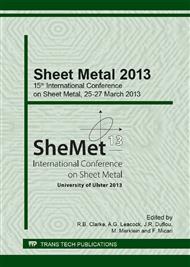p.407
p.415
p.423
p.429
p.436
p.444
p.452
p.463
p.471
Simulation of a Thick Plate Forming Benchmark Using a Multi Scale Texture Evolution and Anisotropic Plasticity Model
Abstract:
Thick plate and sheet materials are often characterised by an inhomogeneous distribution of properties such as yield strength and anisotropy throughout their thickness. Forming of these materials involves further heterogeneous evolution of these properties. A recently developed computational framework [1, now allows these heterogeneities to be modelled via a hierarchical multi-scale material modelling scheme: the evolution of texture and plastic anisotropy can be tracked and individually updated at every integration point in a finite element model, in a computationally efficient manner. In this paper we present the application of this multi-scale model to a benchmark forming simulation, the three point bending test of thick plate steels. A number of hot rolled high strength low alloy steels were considered, two of which are presented here. The results of the simulations are validated against experimental results. Comparison is made between computed and experimental deformed shapes and strain fields, using data acquired by digital image correlation. Predictions of heterogeneously evolved textures are compared with experimental macro-textures, acquired by XRD, at key locations in the final deformed samples. Such models for plate steel forming simulations that are able to provide accurate predictions of deformation textures and derived quantities in the entire volume of the material can be crucial to study further processing steps and properties of the final product.
Info:
Periodical:
Pages:
436-443
Citation:
Online since:
April 2013
Keywords:
Price:
Сopyright:
© 2013 Trans Tech Publications Ltd. All Rights Reserved
Share:
Citation:


